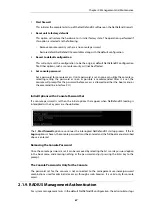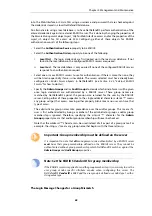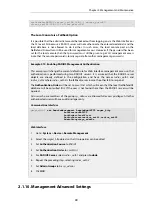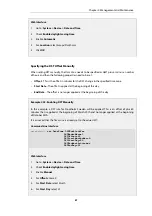
address book entries, service definitions, IP rules and so on. Each configuration object has a
number of properties that constitute the values of the object.
Object Types
A configuration object has a well-defined type. The type defines the properties that are available
for the configuration object, as well as the constraints for those properties. For instance, the
IP4Address
type is used for all configuration objects representing a named IPv4 address.
Object Organization
In the Web Interface the configuration objects are organized into a tree-like structure based on
the type of the object.
In the CLI, similar configuration object types are grouped together in a
category
. These categories
are different from the structure used in the Web Interface to allow quick access to the
configuration objects in the CLI. The IP4Address, IP4Group and EthernetAddress types are, for
instance, grouped in a category named
Address
, as they all represent different addresses.
Consequently, Ethernet and VLAN objects are all grouped in a category named
Interface
, as they
are all interface objects. The categories have actually no impact on the system configuration;
they are merely provided as means to simplify administration.
The following examples show how to manipulate objects.
Example 2.11. Listing Configuration Objects
To find out what configuration objects exist, you can retrieve a listing of the objects. This
example shows how to list all service objects.
Command-Line Interface
gw-world:/> show Service
A list of all services will be displayed, grouped by their respective type.
Web Interface
1.
Go to: Objects > Services
2.
A web page listing all services will be presented.
A list contains the following basic elements:
•
Add Button - Displays a dropdown menu when clicked. The menu will list all types of
configuration items that can be added to the list.
•
Header - The header row displays the titles of the columns in the list. The tiny arrow images
next to each title can be used for sorting the list according to that column.
•
Rows - Each row in the list corresponds to one configuration item. Most commonly, each row
starts with the name of the object (if the item has a name), followed by values for the
columns in the list.
A single row in the list can be selected by clicking on the row on a spot where there is no
hyperlink. The background color of the row will turn dark blue. Right-clicking the row will display
a menu which gives the option to edit or delete the object as well as modify the order of the
objects.
Chapter 2: Management and Maintenance
72
Summary of Contents for NetDefendOS
Page 30: ...Figure 1 3 Packet Flow Schematic Part III Chapter 1 NetDefendOS Overview 30 ...
Page 32: ...Chapter 1 NetDefendOS Overview 32 ...
Page 144: ...Chapter 2 Management and Maintenance 144 ...
Page 284: ...Chapter 3 Fundamentals 284 ...
Page 392: ...Chapter 4 Routing 392 ...
Page 419: ... Host 2001 DB8 1 MAC 00 90 12 13 14 15 5 Click OK Chapter 5 DHCP Services 419 ...
Page 420: ...Chapter 5 DHCP Services 420 ...
Page 573: ...Chapter 6 Security Mechanisms 573 ...
Page 607: ...Chapter 7 Address Translation 607 ...
Page 666: ...Chapter 8 User Authentication 666 ...
Page 775: ...Chapter 9 VPN 775 ...
Page 819: ...Chapter 10 Traffic Management 819 ...
Page 842: ...Chapter 11 High Availability 842 ...
Page 866: ...Default Enabled Chapter 13 Advanced Settings 866 ...
Page 879: ...Chapter 13 Advanced Settings 879 ...






































